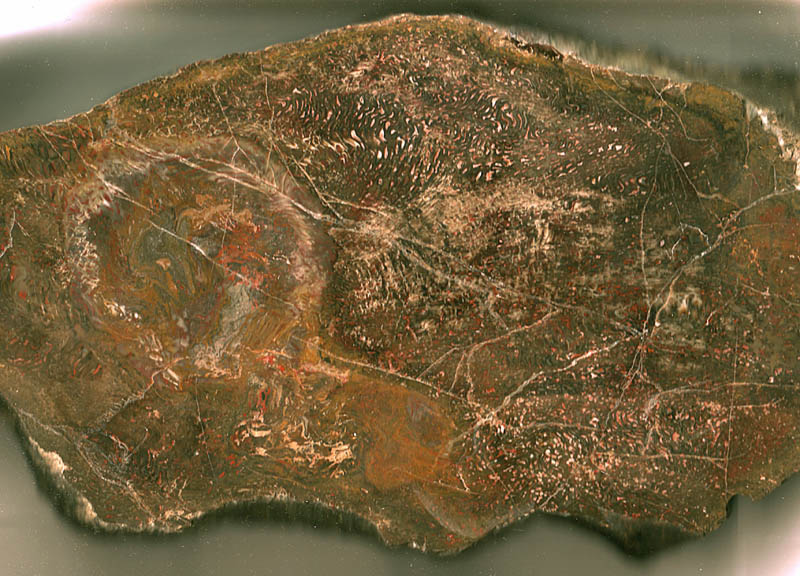A big Psaronius from
Döhlen basin,
Saxony
Chert layer fragments with parts of a Lower
Permian vegetation were found in considerable numbers in the small
Döhlen basin in the 1990s after this type of fossils from the
scientifically important site had been neglected by
palaeobotanists, in the absence of new
finds, for
about a century. The renewed interest was brought about by
Gert
Müller, whose purposeful search on and around the
small area named "Kleinnaundorf fields" in
old palaeobotany texts
yielded cherts with foliage of the tree fern Scolecopteris ( =
Maggot fern, see Permian
Chert News 2)
and with parts of squeezed stems of this fern, known as Psaronius, from
1985 on.
Own activities in fossil collecting in the
Döhlen basin got a boost by contact with M. Barthel
[1] und W. Reichel
[2]. A useful
hint by Herbert
Wossilat
concerning construction pits in chert-bearing sediments led to the
recovery of
lots of fossiliferous chert and petrified wood samples and to the
discovery of
the biggest Psaronius hitherto found in the Döhlen
basin.
 Image:
Cross-section of the largest Psaronius
found hitherto in the Lower
Permian Döhlen basin, unevenly compressed before silicification, width
36.5cm, width of the picture 29.5cm.
Image:
Cross-section of the largest Psaronius
found hitherto in the Lower
Permian Döhlen basin, unevenly compressed before silicification, width
36.5cm, width of the picture 29.5cm.
Parts of tree ferns trunks are found in the Döhlen Basin usually as
components of silicified peat or swamp matter, more or less squeezed
flat, with estimated stem diameters seldom exceeding 20cm. Thus they
never make a sight as magnificient as those found at Chemnitz [3] which
apparently became quickly silicified whilst buried in volcanic ash
without being compressed. Separate Psaronius
samples, like the big
chunks of petrified wood not embedded in chert and less deformed, as
the one shown here, are rare exceptions in the Döhlen basin. (See also Permian
Chert News 6.)
The present sample is thoroughly silicified but was already slightly
damaged before. Some details are enigmatic. The 10cm wide roughly
circular area set off by colour on the left is an artifact of
silicification, possibly controlled by some kind of rot, propagating
outward from the anatomic centre, whose remnants are vaguely seen
inside. (Remember that any Psaronius
stem, except for the uppermost
part, consists of a more or less broad centre with sclerenchyma strands
surrounded by a more or less thick mantle of aerial roots.) Asymmetric
growth is a common phenomenon, also known with Psaronius from
Chemnitz
[3].
The presence of the nearly circular ring beside flattened aerial roots
seems to indicate that low pH due to decay induced early silicification
within the circular area so that it kept its form while the vicinity
became squeezed. This process must have been a complex one, judging
from the different deformation of the aerial roots, which are either
flattened or compressed and kinked lengthwise.
This specimen of 30kg was found in 1995 at Freital-Burgk,
Bernhardts Weg 25,
along with numerous samples of fossiliferous chert and petrified wood
with weight ranging from 27g to 47kg. It had been cut into 8 parts. One
slab had been acquired by the Museum für Naturkunde Chemnitz in
exchange for a Psaronius
slab from Chemnitz, and is pictured in [3],
Fig.195. The slab pictured above is kept in the own collection,
labelled Bu4/52.4. Part Bu4/52.1 is owned by Frank + Uta Lippert,
whose
cooperation was helpful in recovering the finds on their property.
H.-J.
Weiss 2012
[1] M.
Barthel:
Der Madenstein aus dem Rotliegenden des Windberges.
in: H. Prescher
u.a.: Zeugnisse der Erdgeschichte Sachsens, Leipzig 1987, S.121.
[2] K.
Thalheim, W.
Reichel, Th. Witzke: Die
Minerale des Döhlener Beckens. Schriften
Staatl. Mus. Geol. Mineral. Dresden
3(1991), S.53.
[3] R.
Rößler:
Der versteinerte Wald von Chemnitz. Naturkunde-Museum Chemnitz, 2001.
|
 |
 9 9 |

 9
9 Image:
Cross-section of the largest Psaronius
found hitherto in the Lower
Permian Döhlen basin, unevenly compressed before silicification, width
36.5cm, width of the picture 29.5cm.
Image:
Cross-section of the largest Psaronius
found hitherto in the Lower
Permian Döhlen basin, unevenly compressed before silicification, width
36.5cm, width of the picture 29.5cm.
 9
9